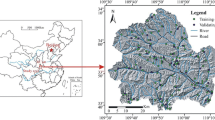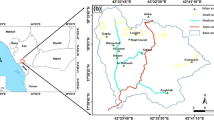Abstract
The main objective of this study is to investigate potential application of frequency ratio (FR), weights of evidence (WoE), and statistical index (SI) models for landslide susceptibility mapping in a part of Mazandaran Province, Iran. First, a landslide inventory map was constructed from various sources. The landslide inventory map was then randomly divided in a ratio of 70/30 for training and validation of the models, respectively. Second, 13 landslide conditioning factors including slope degree, slope aspect, altitude, plan curvature, stream power index, topographic wetness index, sediment transport index, topographic roughness index, lithology, distance from streams, faults, roads, and land use type were prepared, and the relationships between these factors and the landslide inventory map were extracted by using the mentioned models. Subsequently, the multi-class weighted factors were used to generate landslide susceptibility maps. Finally, the susceptibility maps were verified and compared using several methods including receiver operating characteristic curve with the areas under the curve (AUC), landslide density, and spatially agreed area analyses. The success rate curve showed that the AUC for FR, WoE, and SI models was 81.51, 79.43, and 81.27, respectively. The prediction rate curve demonstrated that the AUC achieved by the three models was 80.44, 77.94, and 79.55, respectively. Although the sensitivity analysis using the FR model revealed that the modeling process was sensitive to input factors, the accuracy results suggest that the three models used in this study can be effective approaches for landslide susceptibility mapping in Mazandaran Province, and the resultant susceptibility maps are trustworthy for hazard mitigation strategies.











Similar content being viewed by others
References
Anderson MG, Holcombe E (2013) Community-based landslide risk reduction: managing disasters in small steps. World Bank Publications, Washington
Ardizzone F, Cardinali M, Galli M, Guzzetti F, Reichenbach P (2007) Identification and mapping of recent rainfall-induced landslides using elevation data collected by airborne LiDAR. Nat Hazard Earth Syst Sci 7:637–650
Ayalew L, Yamagishi H (2005) The application of GIS-based logistic regression for landslide susceptibility mapping in the Kakuda-Yahiko Mountains, Central Japan. Geomorphology 65(1–2):15–31
Bijukchhen SM, Kayastha P, Dhital MR (2013) A comparative evaluation of heuristic and bivariate statistical modelling for landslide susceptibility mappings in Ghurmi–Dhad Khola, east Nepal. Arab J Geosci 6(8):2727–2743
Bonham-Carter GF, Agterberg FP, Wright DF (1989) Weights of evidence modelling: a new approach to mapping mineral potential. Stat Appl Earth Sci 89(9):171–183
Bui DT, Pradhan B, Lofman O, Revhaug I, Dick OB (2012) Spatial prediction of landslide hazards in Vietnam: a comparative assessment of the efficacy of evidential belief functions and fuzzy logic models. CATENA 96:28–40
Catani F, Lagomarsino D, Segoni S, Tofani V (2013) Landslide susceptibility estimation by random forests technique: sensitivity and scaling issues. Nat Hazards Earth Syst Sci 13(11):2815–2831
Chung CJF, Fabbri AG (1998) Three Bayesian prediction models for landslide hazard. In: Buccianti A, Nardi G, Potenza R (eds) Proceedings of international association for mathematical geology 1998 annual meeting (IAMG’98), Ischia, Italy, October 1998, pp 204–211
Chung CJF, Fabbri AG (2003) Validation of spatial prediction models for landslide hazard mapping. Nat Hazards 30:451–472
Cruden DM (1991) A simple definition of a landslide. Bull Int Assoc Eng Geol 43:27–29
Dai FC, Lee CF, Xu ZW (2001) Assessment of landslide susceptibility on the natural terrain of Lantau Island, Hong Kong. Environ Geol 40(3):381–391
Darvishzadeh A (2004) Geology of Iran. Amirkabir Publisher, Tehran (In Persian)
Ghimire M (2011) Landslide occurrence and its relation with terrain factors in the Siwalik Hills, Nepal: case study of susceptibility assessment in three basins. Nat Hazards 56(1):299–320
Glade T, Crozier MJ (2005) A review of scale dependency in landslide hazard and risk analysis. Landslide hazard and risk. Wiley, Chichester, pp 75–138
Gorsevski PV, Jankowski P (2010) An optimized solution of multi-criteria evaluation analysis of landslide susceptibility using fuzzy sets and Kalman filter. Comput Geosci 36(8):1005–1020
Gorsevski PV, Gessler PE, Jankowski P (2003) Integrating a fuzzy k-means classification and a Bayesian approach for spatial prediction of landslide hazard. J Geogr Syst 5(3):223–251
Gorsevski PV, Jankowski P, Gessler PE (2005) Spatial prediction of landslide hazard using fuzzy k-means and Dempster–Shafer theory. Trans GIS 9(4):455–474
Gorsevski PV, Gessler PE, Boll J, Elliot WJ, Foltz RB (2006) Spatially and temporally distributed modeling of landslide susceptibility. Geomorphology 80(3–4):178–198
Guillard C, Zezere J (2012) Landslide susceptibility assessment and validation in the framework of municipal planning in Portugal: the case of Loures municipality. Environ Manag 50(4):721–735
Guzzetti F, Carrara A, Cardinali M, Reichenbach P (1999) Landslide hazard evaluation: a review of current techniques and their application in a multi-scale study, Central Italy. Geomorphology 31(1):181–216
Hair JF, Black WC, Babin BJ, Anderson RE, Tatham RL (2006) Multivariate data analysis, vol 6. Pearson Prentice Hall, Upper Saddle River, NJ
Hong H, Pradhan B, Xu C, Bui DT (2015) Spatial prediction of landslide hazard at the Yihuang area (China) using two-class kernel logistic regression, alternating decision tree and support vector machines. CATENA 133:266–281
Jaafari A, Najafi A, Pourghasemi HR, Rezaeian J, Sattarian A (2014) GIS-based frequency ratio and index of entropy models for landslide susceptibility assessment in the Caspian forest, northern Iran. Int J Environ Sci Technol 11(4):909–926
Jaafari A, Najafi A, Rezaeian J, Sattarian A (2015a) Modeling erosion and sediment delivery from unpaved roads in the north mountainous forest of Iran. GEM Int J Geomath 6(2):343–356
Jaafari A, Najafi A, Rezaeian J, Sattarian A, Ghajar I (2015b) Planning road networks in landslide-prone areas: a case study from the northern forests of Iran. Land Use Policy 47:198–208
Jaafari A, Mafi Gholami D, Zenner EK (2017a) A Bayesian modeling of wildfire probability in the Zagros Mountains, Iran. Ecol Inform 39:32–44
Jaafari A, Rezaeian J, Omrani MSO (2017b) Spatial prediction of slope failures in support of forestry operations safety. Croat J For Eng 38(1):107–118
Jebur MN, Pradhan B, Tehrany MS (2014) Optimization of landslide conditioning factors using very high-resolution airborne laser scanning (LiDAR) data at catchment scale. Remote Sens Environ 152:150–165
Kayastha P, Dhital MR, De Smedt F (2012) Landslide susceptibility mapping using the weight of evidence method in the Tinau watershed, Nepal. Nat Hazards 63(2):479–498
Kayastha P, Dhital MR, De Smedt F (2013) Evaluation of the consistency of landslide susceptibility mapping: a case study from the Kankai watershed in east Nepal. Landslides 10(6):785–799
Lee S, Min K (2001) Statistical analysis of landslide susceptibility at Yongin, Korea. Environ Geol 40:1095–1113
Lee S, Pradhan B (2007) Landslide hazard mapping at Selangor, Malaysia using frequency ratio and logistic regression models. Landslides 4:33–41
Mohammady M, Pourghasemi HR, Pradhan B (2012) Landslide susceptibility mapping at Golestan Province Iran: a comparison between frequency ratio, Dempster–Shafer, and weights-of evidence models. J Asian Earth Sci 61:221–236
Montgomery DR, Dietrich WE (1994) A physically based model for the topographic control on shallow landsliding. Water Resour Res 30(4):1153–1171
Nami MH, Jaafari A, Fallah M, Nabiuni S (2017) Spatial prediction of wildfire probability in the Hyrcanian ecoregion using evidential belief function model and GIS. Int J Environ Sci Technol. doi:10.1007/s13762-017-1371-6
Nefeslioglu HA, Gokceoglu C, Sonmez H (2008) An assessment on the use of logistic regression and artificial neural networks with different sampling strategies for the preparation of landslide susceptibility maps. Eng Geol 97(3):171–191
Oh HJ, Kim YS, Choi JK, Park E, Lee S (2011) GIS mapping of regional probabilistic groundwater potential in the area of Pohang City. Korea J Hydrol 399(3):158–172
Ozdemir A, Altural T (2013) A comparative study of frequency ratio, weights of evidence and logistic regression methods for landslide susceptibility mapping: Sultan Mountains, SW Turkey. J Asian Earth Sci 64:180–197
Pham BT, Pradhan B, Bui DT, Prakash I, Dholakia MB (2016) A comparative study of different machine learning methods for landslide susceptibility assessment: a case study of Uttarakhand area (India). Environ Model Soft 84:240–250
Pham BT, Bui DT, Prakash I, Dholakia MB (2017) Hybrid integration of multilayer perceptron neural networks and machine learning ensembles for landslide susceptibility assessment at Himalayan area (India) using GIS. CATENA 149:52–63
Pourghasemi HR, Mohammady M, Pradhan B (2012) Landslide susceptibility mapping using index of entropy and conditional probability models in GIS: Safarood Basin, Iran. CATENA 97:71–84
Pourghasemi HR, Moradi HR, Aghda SF (2013) Landslide susceptibility mapping by binary logistic regression, analytical hierarchy process, and statistical index models and assessment of their performances. Nat Hazards 69(1):749–779
Pradhan B (2013) A comparative study on the predictive ability of the decision tree, support vector machine and neuro-fuzzy models in landslide susceptibility mapping using GIS. Comput Geosci 51:350–365
Regmi AD, Devkota KC, Yoshida K, Pradhan B, Pourghasemi HR, Kumamoto T, Akgun A (2014) Application of frequency ratio, statistical index, and weights-of-evidence models and their comparison in landslide susceptibility mapping in Central Nepal Himalaya. Arab J Geosci 7(2):725–742
van Westen C (1997) Statistical landslide hazard analysis. ILWIS 2.1 for Windows application guide. ITC Publication, Enschede, pp 73–84
Wu W, Sidle RC (1995) A distributed slope stability model for steep forested basins. Water Resour Res 31(8):2097–2110
Xu C, Xu X, Dai F, Saraf AK (2012) Comparison of different models for susceptibility mapping of earthquake triggered landslides related with the 2008 Wenchuan earthquake in China. Comput Geosci 46:317–329
Yalcin A, Reis S, Aydinoglu AC, Yomralioglu T (2011) A GIS-based comparative study of frequency ratio, analytical hierarchy process, bivariate statistics and logistics regression methods for landslide susceptibility mapping in Trabzon, NE Turkey. CATENA 85(3):274–287
Yesilnacar EK (2005) The application of computational intelligence to landslide susceptibility mapping in Turkey. Ph.D. thesis, Department of Geomatics the University of Melbourne, 423 pp
Youssef AM, Pourghasemi HR, El-Haddad BA, Dhahry BK (2016) Landslide susceptibility maps using different probabilistic and bivariate statistical models and comparison of their performance at Wadi Itwad Basin, Asir Region, Saudi Arabia. Bull Eng Geol Environ 75(1):63–87
Zweig MH, Campbell G (1993) Receiver-operating characteristic (ROC) plots: a fundamental evaluation tool in clinical medicine. Clin Chem 39(4):561–577
Acknowledgement
The authors thank three anonymous reviewers who provided many helpful comments and suggestions for improving this manuscript.
Author information
Authors and Affiliations
Corresponding author
Rights and permissions
About this article
Cite this article
Razavizadeh, S., Solaimani, K., Massironi, M. et al. Mapping landslide susceptibility with frequency ratio, statistical index, and weights of evidence models: a case study in northern Iran. Environ Earth Sci 76, 499 (2017). https://doi.org/10.1007/s12665-017-6839-7
Received:
Accepted:
Published:
DOI: https://doi.org/10.1007/s12665-017-6839-7




